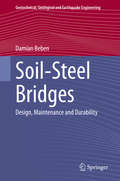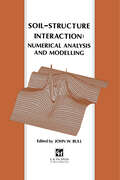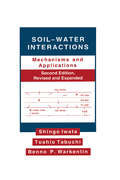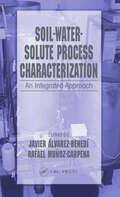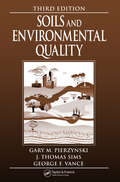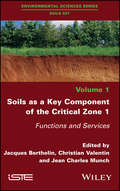- Table View
- List View
Soil-Steel Bridges: Design, Maintenance and Durability (Geotechnical, Geological and Earthquake Engineering #49)
by Damian BebenThe primary objective of this book is to provide designers with a set of analysis and design specifications for soil-steel bridges and culverts, also called flexible structures. Brief but informative, this guide is based on a quick look up approach to code applications, design and analysis methods/calculations as well as applications and solved examples. The book addresses the unique aspects of soil-steel bridges: design and analysis as well as examples of applications, numerical analysis and modeling techniques, corrosion and durability problems, service life and maintenance, and impact of moving loads.
Soil-Structure Interaction: Numerical Analysis and Modelling
by John W. BullThis book describes how a number of different methods of analysis and modelling, including the boundary element method, the finite element method, and a range of classical methods, are used to answer some of the questions associated with soil-structure interaction.
Soil-Water Interactions: Mechanisms Applications, Second Edition, Revised Expanded (Books In Soils, Plants And The Environment #Vol. 14)
by Shingo IwataEmphasizing pioneering achievements, this work offers a clear and systematic description of various soil-water phenomena and their applications to soil problems such as water retention and the flux of water in soils and clays. This second edition contains material on the physical properties of adsorbed water, the application of fractal theory to solute and water flows in field soils, fingering research, and more.
Soil-Water, Agriculture, and Climate Change: Exploring Linkages (Water Science and Technology Library #113)
by Pankaj Kumar Gupta Swatantra Kumar Dubey Prakash Kumar Jha Aliva Nanda Vivek GuptaThis book presents an exploration of linkages among soil-water, agriculture, and climate change with a special focus on thematic areas for assessment, mitigation, and management of natural resources under climate change conditions. This book covers advances in modelling approaches, including machine learning (ML)/ artificial intelligence (AI) applications; GIS and remote sensing; sensors; impacts of climate change on agriculture; subsurface water; contaminants; and socio-economic impacts, which are lacking in a more comprehensive manner in the previous titles. This book encompasses updated information as well as future directions for researchers working in the field of management of natural resources. The goal of this book is to provide scientific evidence to researchers and policymakers and end-to-end value chain practitioners which may help in reducing the overall adverse impacts of climate change on water resources and the related mitigation strategies. This book focuses on the knowledge, modern tools, and techniques, i.e., machine learning, artificial intelligence, etc. for soil-water, agriculture, and climate change. Further, nature-based solutions for management of natural resources with special targets on contaminants, extreme events, disturbances, etc. will be targeted. The book provides readers with the enhanced knowledge for application of engineering principles and economic and regulatory constraints to determine a soil-water, agriculture production action strategy, and select appropriate technologies to implement the strategy for a given data set at a site. It would also cover the application of laboratory, modeling, numerical methods for determination and forecasting of climate change impacts, agriculture production, pollution, soil health, etc. Overall, it provides hydrologists, environmental engineers, administrators, policy makers, consultants, and industrial experts with essential support in effective management of soils health, agricultural productions, and mitigation of extreme climatic events.
Soil-Water-Solute Process Characterization: An Integrated Approach
by Javier Álvarez-Benedí Rafael Muñoz-CarpenaThe practitioner or researcher often faces complex alternatives when selecting a method to characterize properties governing a soil process. After years of research and development, environmental and agricultural professionals now have an array of methods for characterizing soil processes. Well-established methods, however, may not be suitable for
Soilborne Microbial Plant Pathogens and Disease Management, Volume One: Nature and Biology
by P. NarayanasamySoilborne microbial plant pathogens including oomycetes, fungi, bacteria and viruses cause several economically important destructive diseases and the symptoms of infection can be recognized only after the pathogen has invaded many tissues primarily vascular tissues of susceptible plants. This condition places formidable challenges in investigating different aspects of host-microbial pathogen interactions. Early detection of infection and precise identification, differentiation, and quantification of the microbial plant pathogens in plants, soil and water sources are essential requirements for development of effective tactics to reduce the incidence and spread of the diseases caused by them. As the microbial plant pathogens differ in their virulence and sensitivity to the environment and chemicals applied, it is imperative to assess the extent of variability in the concerned pathogens. This first volume of a two-volume set introduces disease-causing microorganisms including oomycetes, fungi, bacteria, and viruses found in soils. It focuses on the biology, detection, and identification of soilborne bacterial, fungal, and viral plant pathogens. This volume discusses various techniques based on biological, immunological and genetic properties of the pathogens indicating their advantages and limitations for selecting the appropriate technique to fulfill the requirements. Features: Presents techniques useful for detection, identification, quantification of microbial plant pathogens in plants, soil, and irrigation water from waterbodies. Highlights subversive activities of viruses, resulting in the breakdown of host defense systems. Discusses RNA silencing in infected plants by viruses and posttranscriptional gene silencing (PTGS) functioning as an endogenous mechanism in plants against virus infection. Presents information on methods of assessment of genetic variability and sensitivity of microbial plant pathogens to chemicals and adverse environmental conditions.
Soilborne Microbial Plant Pathogens and Disease Management, Volume Two: Management of Crop Diseases
by P. NarayanasamyCrop disease management strategies revolve around the principles of exclusion, eradication and immunization. Cultural practices are aimed at preventing or reducing the accumulation of pathogen population (inoculum). Development of cultivars with genetic resistance by transgressing resistance gene(s) through traditional breeding procedures or biotechnological techniques is the most effective and acceptable strategy, as it is environment-friendly and does not need any additional cost to the grower. Assessment of different grades of resistance of cultivars or genotypes to soilborne microbial pathogens has been possible by quantifying pathogen populations or their DNA contents in the test plants by applying biological and molecular methods. This second volume of a two-volume set focuses on the soilborne microbial plant pathogens and the diseases caused by them. The book provides information on ecology and epidemiology of soilborne microbial plant pathogens and various strategies applicable for effective management of diseases. Chapters cover exclusion and prevention strategies; improvement of host plant resistance; biological management; application of chemicals; and integration of these disease management strategies. Features Discusses various aspects of soilborne microbial plant pathogens to develop effective methods of managing diseases. Presents information on epidemiology and ecology of soilborne microbial plant pathogens. Facilitates the application of management strategies alone or in combination with others for effective suppression of disease development. Features information on application of biotic and abiotic biological control agents (BCAs) to suppress pathogen development either by directly acting on the pathogen(s) or indirectly by enhancing host resistance to the pathogens. Employs biotic and abiotic biocontrol agents either to replace or reduce the use of chemicals is an achievable approach for managing the soilborne microbial pathogens.
Soils
by Randall J. Schaetzl Michael L. ThompsonSoils: Genesis and Geomorphology is a comprehensive and accessible textbook on all aspects of soils. The book's introductory chapters on soil morphology, physics, mineralogy and organisms prepare the reader for the more advanced and thorough treatment that follows. Theory and processes of soil genesis and geomorphology form the backbone of the book, rather than the emphasis on soil classification that permeates other less imaginative soils textbooks. This refreshingly readable text takes a truly global perspective, with many examples from around the world sprinkled throughout. Replete with hundreds of high quality figures and a large glossary, this book will be invaluable for anyone studying soils, landforms and landscape change. Soils: Genesis and Geomorphology is an ideal textbook for mid- to upper-level undergraduate and graduate level courses in soils, pedology and geomorphology. It will also be an invaluable reference text for researchers.
Soils Under Stress: More Work for Soil Science in Ukraine
by David Dent Yuriy DmytrukDokuchaev carried out most of his research in Ukraine. His student and friend, Volodymyr Vernadsky, went on to create trans-disciplinary environmental sciences and the concept of Earth as a living organism, famously taken up by James Lovelock. That spring of ideas still flows and the researches captured in this volume are relevant to present-day problems, and not only in Ukraine.Soils have always been under stress but, in the Anthropocene, mankind is in the driving seat. As a sequel to Soil Science Working for a Living: Applications of soil science to present-day problems, we consider issues of policy as well as soil genesis, attributes and functions in various environments, natural and man-made. We consider human impacts on the soil cover through its use and misuse, highlight methods of research and assessment of soil quality, and the threats of soil degradation. The distinguished contributors also describe and propose various options for evaluation and remediation of degraded soils, drawing on the latest methods of modelling and cartography as well as long-term field experiments and long experience.The book will be invaluable to researchers and practitioners in soil science including graduate and post-graduate education, academics and professionals.
Soils and Environmental Quality
by Gary M. Pierzynski George F. Vance J. Thomas SimsA perpetual bestseller, this third edition explores environmental quality from the perspective of soil science. The coverage ranges from the theoretical to the practical with an abundance of examples such as an exploration of allowable pesticide concentrations in drinking water and an inquiry into soil contamination from the trace elements in organic by-products. It also explores the use of soil carbon sequestration as a remedy for global climate change and the effects of acid precipitation on forestation. Case studies with political, economic, and legal implications illustrate the human side of environmental problems. Also covered is the use or misuse of the Scientific Method and the potential for factual bias.The three authors, all teaching professors distinguished in soil science, have updated this student favorite to include a greater number of even more relevant topics. Responding to reques
Soils and Geotechnology in Construction
by Alan J. LuteneggerThis book covers the field of applied geotechnology related to all aspects of construction in ground, including compacted fill, excavations, ground improvement, foundations, earth retaining systems and geotechnical site characterization. It suits the first year of a graduate course on ground improvement and geoconstruction and will suit practicing engineers, both consultants and contractors. Distinctively it covers the identification of problematic soils and appropriate mitigation measures, and the inspection of ground construction work. It combines the technical and the practical in applied geotechnology.
Soils and Groundwater Pollution and Remediation: Asia, Africa, and Oceania
by P. M. Huang I.K. IskandarThe increasing population densities of Asia, Africa and Oceania are in conflict with the ecosystem. A growing demand for food and fiber causes agriculture to rely heavily upon chemical fertilization, herbicides and pesticides. Rising industrial output creates higher contamination from cadmium, lead, selenium, and other metals. Soils and Groundwater Remediation explores the toxic levels of metals, radionuclides, inorganics, and anthropogenic organic compounds found in the soils and groundwater of Asia, Africa and Oceania. This 14 chapter book reviews the distribution, transformation, and dynamics of the pollutants. The authors also reflect on the impact of Acid-rain. The contributors to this book are well-known scientists from Japan, China, Korea, Malaysia, New Zealand, Australia, and Kenya. The authors address their findings to researchers, educators, government regulators, and students. As the title suggests, the book is ultimately concerned with remediation. Huang and Iskandar feel "the potential for restoring ecosystem health ... in these areas is enormous." The contributions of Soils and Groundwater Remediation will bring science closer to achieving that possibility.
Soils and Human Health
by Eric C. Brevik Lynn C. BurgessDespite the connections between soils and human health, there has not been a great amount of attention focused on this area when compared to many other fields of scientific and medical study. Soils and Human Health brings together authors from diverse fields with an interest in soils and human health, including soil science, geology, geography, bio
Soils as a Key Component of the Critical Zone 1: Functions and Services
by Jean Charles Munch Jacques Berthelin Christian ValentinThis introductory book to the six volume series includes an introduction defining the critical zone for mankind that extends from tree canopy and the lower atmosphere to water table and unweathered rock. Soils play a crucial role through the functions and the services that they provide to mankind. The spatial and temporal variability of soils is represented by information systems whose importance, recent evolutions and increasingly performing applications in France and in the world must be underlined. The soil functions, discussed in this book, focus on the regulation of the water cycle, biophysicochemical cycles and the habitat role of biodiversity. The main services presented are those related to the provision of agricultural, fodder and forest products, energy, as well as materials and the role of soil as infrastructure support. They also include the different cultural dimensions of soils, their representations being often linked to myths and rites, as well as their values of environmental and archaeological records. Finally, the issue is raised of an off-ground world.
Soils in Canada: Geological, Pedological and Engineering Studies (The Royal Society of Canada Special Publications #3)
by Robert LeggetThis work originated in a Symposium forming part of the programme for Section IV (Geological Sciences including Mineralogy) of the Royal Society of Canada, which met at Queen's University, Kingston, in 1960. Of wide scope, it demonstrates the progress now being made in Canada in the study of its vast area of soils. The papers of this Symposium are unique in that they present for the first time a combined picture of three aspects of soil science–the geological, the pedological (or agricultural), and the engineering (known as Soil Mechanics). The book serves, of course, mainly as an introduction to a large subject, but some more detailed papers give an idea of the depth as well as the wide range of soil studies in Canada today. The contents can be summarized as follows. First come seven papers on Pleistocene geology in Canada, followed by a study of muskeg (which forms half a million square miles of Canada's surface) and one of soil mineralogy. Four papers–one general and three regional–of pedological interest follow. Finally come four papers on soil mechanics: one relating agricultural and engineering soil studies; one discussing geology's influence on the siting and building of airports; a detailed account of the properties of Leda clay; and a general review of the soil problems facing the Canadian civil engineer.
Soils in Natural Landscapes
by Earl B. AlexanderIn any complete investigation of terrestrial ecosystems, rocks and soils must be considered. Soils are essential resources, providing water and nutrients for vascular plants, and mitigating the flow of water from the land. In addition, soil diversity is critical for biotic diversity. While there are many references on the agricultural perspective o
Soils in Urban Ecosystem
by Amitava Rakshit Subhadip Ghosh Viacheslav Vasenev Vishnu D. Rajput H. PathakThis book is a compilation of latest work in the field of urban soil management. It explores the global status of urban soils and puts forwards methods for sustainable utilization of urban soils and green spaces.Urban soil study is a new frontier of soil science. Urban soils research is challenging due to complexity of classification, spatial-temporal variability, exposure to pollution and the predominant effect of the anthropogenic factor on soil formation. Management of urban soils and green spaces is an important aspect for developing sustainable spaces. This is a comprehensive collection of information for the students, researchers, landscape architects understanding and maximizing the benefits of soils in urban ecosystems.
Soils in the Hindu Kush Himalayas: Management for Agricultural Land Use (Geography of the Physical Environment)
by Vikas Sharma U. C. Sharma M. DattaThis book focuses on the nature and properties of soils of Hindu Kush-Himalayas and their management for agricultural land use. It discusses all aspects of climatic variations and potential of resources in the Himalayan region including examples from Afghanistan, Bangladesh, Bhutan, China (Tibet), India, Myanmar, Nepal and Pakistan. Chapters cover the geology of the parent material of native soils, soils microbes, flora and fauna. Soil classification has been given in detail to better understand the nature of soils for judicious management strategies. The authors present land use practices and suggestions for changes in land use to benefit from the full potential of the soils in this region. Their ultimate aim is to find ways of feeding the ever-increasing population and raising the standard of life for the people living in the Himalayan mountain region.
Soils in the Humid Tropics and Monsoon Region of Indonesia (Books in Soils, Plants, and the Environment)
by Kim H. TanHighlighting the vast differences in tropical climate, from hot and humid to cool and arctic, Soils in the Humid Tropics and Monsoon Region of Indonesia explores the climate, soil zones, and altitudinal variation in soil formation. The author explores the changes in geomorphology, especially in climate and vegetation above sea level, that ha
Soils of Malaysia
by Muhammad Ashraf Radziah Othman Che IshakThere are approximately 500 different soil varieties in Malaysia, most is residual soil and coastal alluvial soil. This book presents a comprehensive overview of various aspects of soils in Malaysia. It covers topics including climate; flora and fauna; geology and hydrology; land use changes for agriculture; soil fertility; human-induced soil degradation; and soil contamination sources. It features information on the role of biological, chemical, mechanical, and physical factors in relation to soil properties. The book highlights land use impact, soil problems arising from contamination and its control methods, the management of problem soils, limiting materials as well as future soil issues. The presentation of different soils in Malaysia is organized through chapters based on two major soil groups (a) the sedentary soils formed in the interior on a wide range of rock types, and (b) the soils of the coastal alluvial plains. The book features information on how these various soil types affect the economy of the country and highlights the soil issues and challenges within the context of sustainable agriculture. Useful to graduate students of soil science, professionals, and agriculturalists, it provides extensive knowledge of agriculture soils in Malaysia in a concise and user-friendly manner.
Soils of South Africa
by Martin FeySoils of South Africa is the first book in seventy years that provides a comprehensive account of South African soils. The book arranges more than seventy soil forms into fourteen groups and then provides, for each group: • maps showing their distribution and abundance throughout South Africa • descriptions of morphological, chemical and physical properties • a detailed account of classification and its correlation with international systems • a discussion of soil genesis which includes a review of relevant research papers • appraisal of soil quality from a land use perspective as well as for its ecological significance • illustrative examples of soil profiles with analytical data and accompanying interpretations. There is also a fascinating account of the special relationship that exists between South African animals and soil environments. Soils of South Africa should interest students and researchers in the earth, environmental and biological sciences, as well as environmental practitioners, farmers, foresters and civil engineers.
Soils of the Past: An Introduction to Paleopedology
by Gregory J. RetallackA student-friendly textbook that describes ancient soils, how they may be identified, and their use in paleoenvironmental reconstruction Ancient soils contain vital mineralogical, geochemical, textural, and paleontological information about the continental environments in which they formed. Advances in isotope geochemistry and sequence-stratigraphic models allow evermore detailed reconstructions of environmental change from paleosols, and new insights into such diverse topics as atmospheric chemistry, global change, paleoecology, geobiology and mass extinction. This book educates readers about the field of paleopedology and how it remains a key area of investigation for geologists and environmental scientists seeking to learn about, and reconstruct, the condition and evolution of paleoenvironments. Presented in three sections—Soils and Palesols; Factors in Soil Formation; and Fossil Record of Soils—Soils of the Past: An Introduction to Paleopedology describes the main types of ancient soil, procedures for identifying and studying them, their classification and, most significantly, a wide array of examples of how paleosols have been used for paleoenvironmental reconstruction. The book is an excellent reflection of the current state of knowledge and can be widely adopted over many disciplines. All chapters have been revised and updated to reflect advances in soil science in the last two decades New tables display a wealth of new data added since the 2nd edition published in 2001 New figures have been added and line art has been redrawn to improve clarity and promote understanding References have been updated throughout Soils of the Past, 3rd Edition is written for advanced undergraduates studying paleopedology as part of a degree in geology, environmental science, or physical geography, and for interested professional earth scientists.
Soils, Earthwork And Foundations: A Practical Approach; Based 2015 Irc And Ibc
by Dean Read Kirby MeyerA resource for soils and foundations, this book is a bridge between the world of geotechnical engineering and foundation design and construction activities and inspections dealing with soil conditions and building foundations. Updated to the 2015 codes
Soils, Ecosystem Processes, and Agricultural Development
by Shinya FunakawaThe main objective of this book is to integrate environmental knowledge observed in local agriculture, based on the understanding of soils science and ecology, and to propose possible technical solutions and a more integrated approach to tropical agriculture. The chapters describe and analyze the ecological and technical countermeasures available for mitigating environmental degradation due to the increasing agricultural activities by humans, based on our scientific understanding of traditional agriculture in the tropics. This is an effective approach, as such ecological and technical tools previously involved in traditional activities are expected to be easily incorporated into present agricultural systems. The book starts with a rather classical pedological issue and analyzed traditional agricultural practices with different resource management strategies in terms of their modification of natural biological processes. It focuses on the present situation of tropical agriculture; that is, resource utilization in modern agriculture after application of technical innovation (increased application of chemical fertilizers as well as agricultural chemicals). Here, possible technical approaches to resource management that reasonably support agricultural production whilst mitigating environmental degradation are discussed. The negative impacts of agricultural development on our environment are rapidly growing, yet we are increasingly dependent on the agricultural sector for food and energy. The situation is similar in the tropics, where subsistence agriculture with low input management has long comprised most agricultural systems. Comparison of ecological and/or agronomical studies between different continents are still rare; therefore, this analysis may help clarify what is an essential problem when considering technical transportation beyond continents and/or between temperate and tropical regions.
Soils, Plants and Clay Minerals
by Pierre Barré Pierre VeldeThis book considers the inter-relations between plants and minerals in an entirely new way, in that it introduces the notion of eco-engineering: i.e. the manipulation of the mineral world by the living world to the ends of the living world. These inter-relations are the basis for traditional agriculture and should be the basis for new, ecologically oriented land management disciplines, including agriculture itself. These relations also have an impact on surface geochemistry and determine pollution problems. A better understanding of this concept will lead to a renewed consideration of surface environmental problems.
